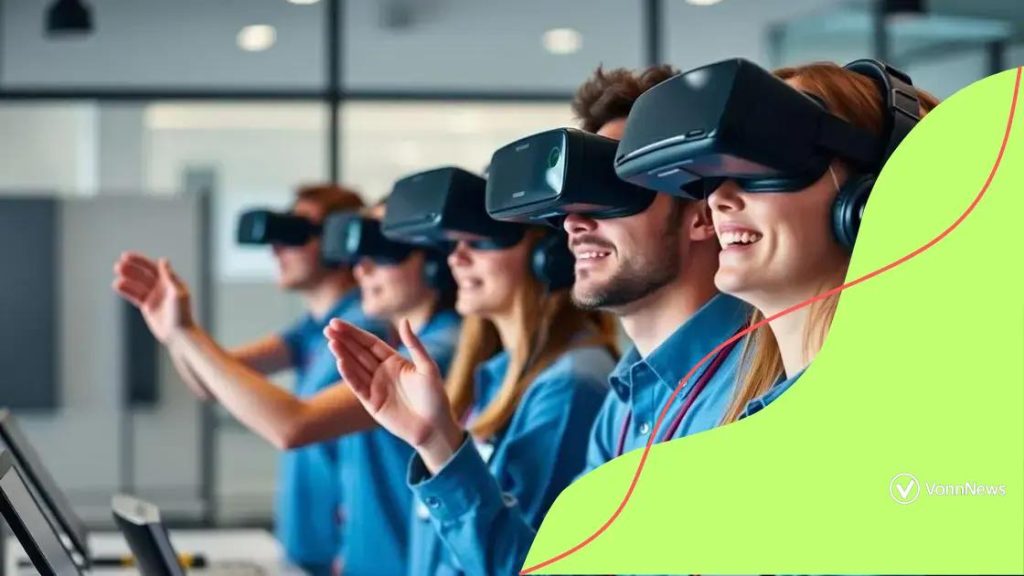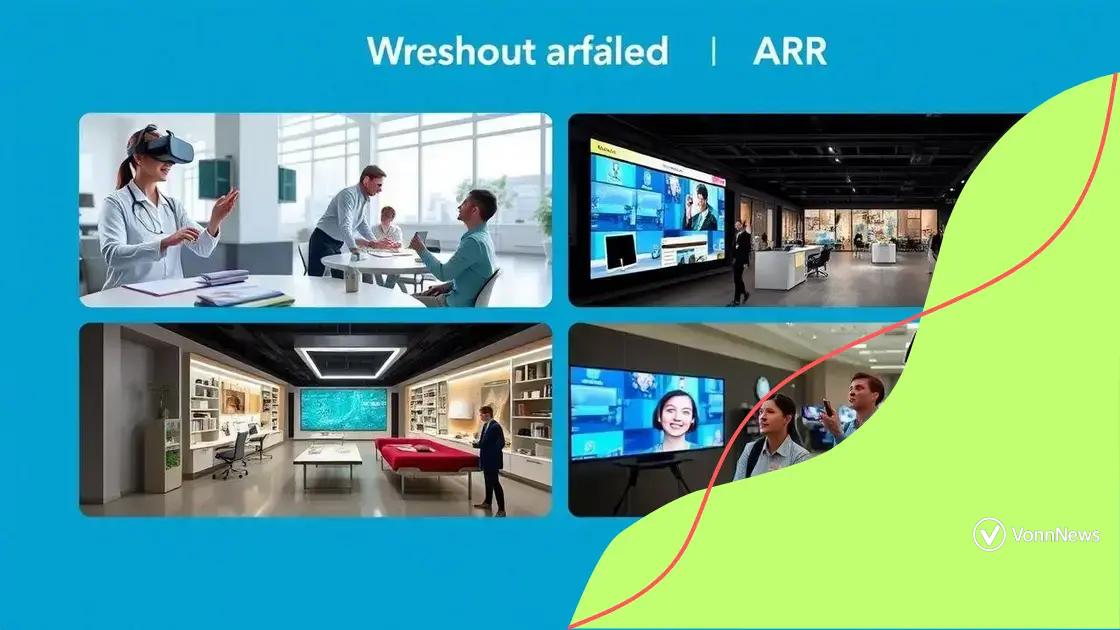VR/AR in job skills training: Transform your learning experience

Anúncios
VR/AR in job skills training enhances learning by providing immersive experiences, improving skill retention, and allowing safe practice in realistic simulations, making it a powerful tool for modern workforce development.
VR/AR in job skills training is reshaping the way we acquire new skills. Have you ever imagined learning in an immersive environment? This article unpacks how these technologies can enhance your training experience.
Anúncios
Understanding VR and AR technologies
Understanding VR and AR technologies is essential for grasping their impact on job skills training. Virtual Reality (VR) immerses users in a computer-generated environment, while Augmented Reality (AR) overlays digital content onto the real world. Together, these technologies create engaging learning experiences.
What is Virtual Reality?
Virtual Reality is an interactive simulation that allows individuals to experience and manipulate a virtual environment. Users typically wear a headset that blocks the real world, fully immersing them in the VR space.
What is Augmented Reality?
Unlike VR, Augmented Reality enhances the real world by adding digital elements. Users can see and interact with both physical and virtual objects simultaneously, often using smartphones or AR glasses.
Both technologies have unique benefits in training. Here are some reasons why they are becoming popular:
- Enhanced Engagement: VR/AR makes training interactive and enjoyable.
- Safe Learning Environment: Users can practice skills without real-world consequences.
- Realistic Simulations: These technologies allow for practice in scenarios that reflect actual job conditions.
Anúncios
Businesses are adopting VR/AR to improve onboarding and professional development. For example, a construction company might use VR to train workers on safety protocols, while healthcare providers can use AR to enhance surgical training.
Studies show that learners retain more information when using VR and AR compared to traditional methods. This is due to the immersive experiences that make learning more memorable. With the right implementation, these technologies can transform skill training and ultimately enhance workplace performance.
Benefits of VR/AR in skills training
When we explore the benefits of VR/AR in skills training, it’s clear that these technologies offer transformative possibilities. They create opportunities for experiential learning that traditional methods cannot match. Learners can practice skills in safe environments, receive instant feedback, and retain information more effectively.
Immersive Learning Experience
Both VR and AR offer immersive experiences that captivate learners. In a VR environment, users can engage fully, forgetting their physical surroundings. This level of immersion enhances focus and encourages deeper learning.
Safe Practice Environment
Another significant advantage is the safe practice environment they provide. For instance, in fields like medicine or construction, these technologies allow learners to practice high-risk tasks without real-world consequences. This way, trainees gain confidence before entering actual work situations.
Using VR and AR can lead to improved skills retention as well. Studies show that interactive learning experiences can boost retention rates significantly. Here are some key benefits to consider:
- Enhanced Engagement: VR/AR captures attention better than traditional learning methods.
- Practical Application: Learners can apply skills in realistic scenarios.
- Customizable Training: Programs can be tailored to meet specific learning needs and goals.
This flexibility makes training more relevant and effective. Companies can also track learner progress in real time. Data analytics from these technologies help assess performance and identify areas in need of improvement. Over time, this can lead to well-trained employees who enhance workplace productivity.
Incorporating VR and AR into training programs not only streamlines skill development but also motivates learners. When training is engaging and relevant, participants are more likely to embrace the learning process and retain what they have learned.
Real-world applications of VR/AR

The real-world applications of VR/AR are expanding rapidly across various industries. These technologies are not just for gaming; they are transforming how businesses train employees and engage with customers. From healthcare to education, VR and AR are making a significant impact.
Healthcare Training
In the medical field, VR is used to simulate surgeries. This allows surgeons to practice complex procedures in a risk-free environment. Medical students can also use VR to gain hands-on experience without the need for live patients. This technology not only enhances their learning but also improves patient safety.
Retail and Marketing
Retailers are using AR to improve customer experience. Shoppers can use their smartphones to see how furniture would look in their homes before purchasing. This interactive experience increases customer satisfaction and can lead to higher sales. Additionally, brands are creating AR advertisements that engage users in unique ways, making them more memorable.
Another exciting application is in education. Schools use VR to take students on virtual field trips, exploring historical sites or the solar system without leaving the classroom. This kind of immersive learning can spark interest and enhance understanding of complex subjects.
Moreover, VR and AR are effective tools for training in industries like manufacturing and aviation. Companies use simulations to train employees on machinery operation, safety protocols, and more. Employees gain practical experience, which helps them prepare for actual job roles.
- Emergency Response: Firefighters use VR simulations to practice rescue operations safely.
- Military Training: Soldiers gain battlefield experience through realistic VR scenarios.
- Construction: AR helps in visualizing building plans before construction begins.
These applications showcase how VR and AR can enhance training and education processes. As technology continues to improve, the potential uses for VR and AR will likely expand even further, benefiting many fields.
Challenges in implementing VR/AR
While the benefits of VR/AR in training are clear, there are also notable challenges in implementing these technologies effectively. Understanding these roadblocks is essential for organizations looking to adopt VR and AR in their training programs.
High Initial Costs
One of the major challenges is the high initial cost of VR/AR technology. Acquiring hardware like headsets and developing software can be expensive. Many organizations may find it difficult to justify these upfront expenses, especially smaller businesses with limited budgets.
Technical Limitations
Another barrier is related to technical limitations. Not all companies have the necessary infrastructure to support VR or AR applications. Issues with hardware compatibility or software integration can hinder effective implementation. Additionally, not every employee may have the technical skills to use these technologies comfortably.
Training staff to use new technologies is a significant hurdle. Employees require proper training not only to use the VR/AR tools but also to maximize the benefits of these platforms. This training process can be time-consuming and may take resources away from other essential activities.
- Resistance to Change: Employees might be hesitant to adopt new technologies, preferring traditional training methods.
- Content Development Challenges: Creating engaging and effective VR/AR content requires skilled professionals, which can be hard to find.
- Safety Concerns: Some users may experience motion sickness or discomfort when using VR, impacting their training experience.
Moreover, organizations need to ensure that the content created for VR and AR is relevant and effective. If the material does not align well with the training objectives, it can result in poor learning outcomes.
These challenges show that while implementing VR and AR can enhance training, it requires careful planning, investment, and ongoing support to overcome potential obstacles. By addressing these issues, organizations can better harness the power of immersive technologies for skill development.
Future trends in job skills training with VR/AR
The future trends in job skills training with VR/AR promise exciting advancements. As technology evolves, so do the ways we learn and develop skills. VR and AR are at the forefront of this transformation, leading to new approaches in workforce education.
Increased Accessibility
One major trend is the increased accessibility of VR and AR technologies. As prices drop, more organizations will be able to adopt these tools. This means that small businesses can also leverage immersive training without breaking the bank.
Personalized Learning
Personalized learning experiences will continue to rise. VR/AR technology can adapt to individual learning styles, providing tailored content that meets specific needs. This customization will help learners grasp complex skills more efficiently.
Another trend is the integration of AI into VR/AR training programs. Artificial Intelligence can analyze user performance and suggest improvements, making training smarter and more responsive. With AI-driven analytics, organizations can gain insights into employee progress and tailor training paths accordingly.
- Collaboration in Virtual Environments: Training will involve more interactive and collaborative elements. Users will work together in virtual settings, fostering teamwork and communication skills.
- Microlearning: Short, focused training modules through VR/AR will become more common. This approach allows users to learn specific skills quickly without overwhelming them.
- Gamification: Game elements integrated into training programs will increase engagement and motivation. Learners will earn rewards for completing modules and reaching milestones.
As VR and AR technologies improve, we can expect more realistic simulations that create authentic training environments. Employers will see a more skilled workforce, and employees will benefit from engaging, effective learning methods. Overall, the landscape of job skills training is set to undergo a remarkable transformation, with VR and AR leading the way.
FAQ – Frequently Asked Questions about VR/AR in Job Skills Training
What are the main benefits of using VR/AR for training?
VR/AR provides immersive learning experiences, enhances engagement, and helps with better retention of skills.
What challenges might organizations face when implementing VR/AR?
High costs, technical issues, and the need for training staff on new technologies can present challenges.
How can VR/AR improve employee training methods?
These technologies offer realistic simulations that allow employees to practice skills in a safe environment.
What future trends should we expect in VR/AR training?
Expect increased accessibility, personalized learning experiences, and more collaborative training environments in the future.